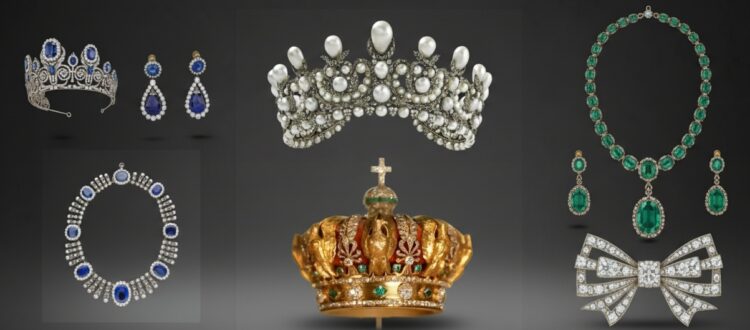Unveiling the Mystery: The Louvre Heist & the Allure of Antique Jewellery
The Louvre Museum, a beacon of art and history in the heart of Paris, holds countless treasures within its hallowed halls.
The Louvre, which was a royal palace for more than two centuries, opened as a public museum in 1793 during the French Revolution, and is no stranger to thefts.
On August 21, 1911, Leonardo da Vinci’s Mona Lisa was stolen from the Louvre Museum in what was deemed the “heist of the century”, and was recovered in 1914.
In 1940, the Nazis invaded France amid World War II and appeared poised to loot a section of the Louvre, but were prevented by the pre-emptive measures taken by the then director of France’s museums, Jacques Jaujard.
In 1990, Pierre Auguste Renoir’s Portrait of a Seated Woman was cut from its frame and stolen from the third floor of the Louvre. At the same time, the museum discovered that some small jewellery items were also missing.
On October 19, 2025, it was subject to the most audacious robbery since the Mona Lisa theft.
During the robbery, a band of thieves stole eight items of jewellery, containing French Crown jewels, from the Napoleonic era.
Join us as we delve into this audacious Louvre jewellery heist, exploring the immense value and historical significance of such pilfered pieces, and connecting them to the enduring appeal of antique and vintage jewellery, including those found at specialized online auction houses like Giftex.

Also Read: Symbolism in Jewellery
The Seven-Minute Heist: A Shocking Breach of Security
The robbery, which occurred around 9:30 AM local time, just half an hour after the museum opened, was an act of incredible audacity and speed. Disguised as construction workers and utilising a vehicle-mounted basket lift to reach an upper-storey window on the Seine-facing façade, the thieves bypassed significant security measures. Once inside the Apollo Gallery, they reportedly used power tools to smash through two display cases, seizing their targets in less than four minutes before making a swift escape on motorbikes.
The estimated monetary value of the stolen pieces is a staggering €88 million (approximately $102 million), but as French officials have stressed, the heritage and historical value of the loot are truly “inestimable.” This loss is not merely financial; it is a cultural wound for France and the world.
But what exactly did the robbers steal, and who did they originally belong to?
Glittering Jewels: Royal History Of The Stolen French Crown Jewels
According to the authorities, eight items were taken, including diadems, necklaces, ear-rings and brooches.
France’s Ministry of Culture said the stolen items were:
- A tiara from the jewellery set of Queen Marie-Amelie and Queen Hortense
- A necklace from the same duo’s sapphire jewellery set
- A single earring from the sapphire jewellery set
- An emerald necklace from a set belonging to Empress Marie-Louise
- A pair of emerald earrings from the Marie-Louise set
- A brooch known as the “reliquary” brooch
- The tiara of Empress Eugenie
- A large brooch of Empress Eugenie
The robbers also stole a ninth item, the crown of Empress Eugenie, wife of Napoleon III. But it was recovered nearby, thought to have been dropped by the thieves.
- The Sapphire and Diamond Set of Queen Marie-Amélie and Queen Hortense

This set comprises a sapphire diadem (tiara), a matching necklace, and a single sapphire earring. This diamond and sapphire jewellery set was worn by Hortense de Beauharnais, Queen of Holland; Marie-Amélie, Queen of the French; and Isabelle d’Orléans, Duchess of Guise. The diadem — a jewelled headpiece worn by royalty — features 24 Ceylon sapphires and 1,083 diamonds that can be detached and worn as brooches.
- The Emerald and Diamond Set of Empress Marie-Louise

Stolen from this collection were a stunning emerald necklace and a pair of emerald earrings. The necklace, a wedding gift from Napoleon Bonaparte to his second wife, Marie-Louise of Austria, in 1810, is a legendary piece, symbolizing the power and opulence of the First French Empire. This stunning jewellery set, crafted by jeweller François-Régnault Nitot, includes 32 intricately cut emeralds and 1,138 diamonds.
- Empress Eugénie’s Jewels

The thieves took a tiara adorned with pearls and nearly 2,000 diamonds, as well as a large diamond-encrusted bodice-bow brooch (reliquary brooch) that belonged to Empress Eugénie, the wife of Napoleon III and was crafted by Paul-Alfred Bapst in 1855, specially for her.
- Stolen but recovered: Eugénie’s Crown

Thieves attempted to steal Empress Eugénie’s crown, but it was found outside the Louvre, according to France’s culture ministry.
The ornate gold piece, which features 1,354 diamonds and 56 emeralds, was damaged in the heist.
The Race Against Time: The Unsaleability of Stolen Treasure
Experts agree that selling these highly recognizable, historically documented pieces intact would be virtually impossible. They have been immediately added to INTERPOL’s Stolen Works of Art database, making them too hot for any reputable collector or auction house to touch.
The most likely scenario, according to investigators, is that the jewels will be dismantled. The priceless settings will be melted down, and the antique-cut diamonds, sapphires, and emeralds will be recut to erase their identity and then sold on the illicit international market. This is the tragic reality of such a theft: the destruction of historical artefacts for their raw material value. It is the ultimate crime against cultural heritage.
The Enduring Magic of Antique Jewellery: A Story Worth Preserving
The Louvre heist serves as a stark, dramatic backdrop to the conversation around antique and vintage jewellery. Why does the market for these pieces continue to thrive, even as some of its most famous examples face such a risk?
- Irreplaceable Craftsmanship: The intricate hand-settings, the specific cuts of the stones (like the Old Mine or Rose Cuts), and the detailed metalwork of antique pieces from eras like the Victorian, Art Nouveau, and Art Deco periods are simply not replicated in modern, mass-produced jewellery.
- Tangible History and Provenance: Whether a ring belonged to a European Queen or a modest brooch was a cherished family heirloom, antique jewellery offers a direct, tangible link to the past. This historical connection infuses each piece with a soul, a narrative that modern jewellery lacks.
- Investment and Rarity: The scarcity of genuine, high-quality antique pieces, combined with the superior materials and craftsmanship, often makes them excellent long-term investments. They offer a unique aesthetic that sets them apart from contemporary styles.
Giftex A World of Collectibles Auction
The market for antique and vintage jewellery is thriving, thanks to increasing appreciation for classical beauty and historical significance. Auction houses play a pivotal role in bringing these treasures to a wider audience and preserving their legacy. Among these, Giftex stands out as a premier online auction house specializing in heirloom and vintage jewellery. Giftex combines tradition with technology, offering a platform where collectors and enthusiasts can explore and bid on exceptional antique jewellery.
Conclusion: A Call to Protect Priceless History
The Louvre heist of October 19, 2025, is a global tragedy—a painful reminder that the fight to protect our cultural heritage is constant. The stolen French Crown Jewels are more than sapphires, emeralds, and diamonds; they are chapters of a nation’s history, now lost to the shadows of the criminal underworld.
Their loss, however, highlights the enduring allure of all antique jewellery. It reinforces why we must cherish and protect the pieces that remain, whether they are world-famous relics in museums or cherished vintage heirlooms waiting to be discovered. Platforms like Giftex Online Auction House play a critical role, not only in providing a legitimate and ethical avenue for trade but also in preserving the appreciation for the artistry and legacy these treasures hold. The search for the stolen jewels is a race against time; the appreciation of authentic, historical jewellery is a timeless pursuit.






